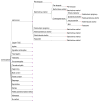Cost effectiveness of contraceptives in the United States
- PMID: 19041435
- PMCID: PMC3638200
- DOI: 10.1016/j.contraception.2008.08.003
Cost effectiveness of contraceptives in the United States
Erratum in
- Contraception. 2009 Aug;80(2):229-30
Abstract
Background: The study was conducted to estimate the relative cost effectiveness of contraceptives in the United States from a payer's perspective.
Methods: A Markov model was constructed to simulate costs for 16 contraceptive methods and no method over a 5-year period. Failure rates, adverse event rates and resource utilization were derived from the literature. Sensitivity analyses were performed on costs and failure rates.
Results: Any contraceptive method is superior to "no method". The three least expensive methods were the copper-T intrauterine device (IUD) (US$647), vasectomy (US$713) and levonorgestrel (LNG)-20 intrauterine system (IUS) (US$930). Results were sensitive to the cost of contraceptive methods, the cost of an unintended pregnancy and plan disenrollment rates.
Conclusion: The copper-T IUD, vasectomy and the LNG-20 IUS are the most cost-effective contraceptive methods available in the United States. Differences in method costs, the cost of an unintended pregnancy and time horizon are influential factors that determine the overall value of a contraceptive method.
Figures



Comment in
-
Update on the cost-effectiveness of contraceptives in the United States.Contraception. 2010 Oct;82(4):391. doi: 10.1016/j.contraception.2010.04.008. Epub 2010 May 18. Contraception. 2010. PMID: 20851236 No abstract available.
-
Update on and correction to the cost effectiveness of contraceptives in the United States.Contraception. 2012 Feb;85(2):218. doi: 10.1016/j.contraception.2011.06.011. Epub 2011 Aug 12. Contraception. 2012. PMID: 22067776 No abstract available.
-
Update on and correction to the cost-effectiveness of contraceptives in the United States.Contraception. 2012 Jun;85(6):611. doi: 10.1016/j.contraception.2012.02.009. Epub 2012 Mar 27. Contraception. 2012. PMID: 22459232 No abstract available.
References
-
- Finer LB, Henshaw SK. Disparities in rates of unintended pregnancy in the United States, 1994 and 2001. Perspect Sex Reprod Health. 2006;38:90–6. - PubMed
-
- Trussell J. The cost of unintended pregnancy in the United States. Contraception. 2007;75:168–70. - PubMed
-
- Mosher WD, Martinez GM, Chandra A, Abma JC, Willson SJ. Use of contraception and use of family planning services in the United States: 1982–2002. Adv Data. 2004:1–36. - PubMed
-
- Chiou CF, Trussell J, Reyes E, et al. Economic analysis of contraceptives for women. Contraception. 2003;68:3–10. - PubMed
Publication types
MeSH terms
Substances
Grants and funding
LinkOut - more resources
Full Text Sources
Other Literature Sources
Medical

